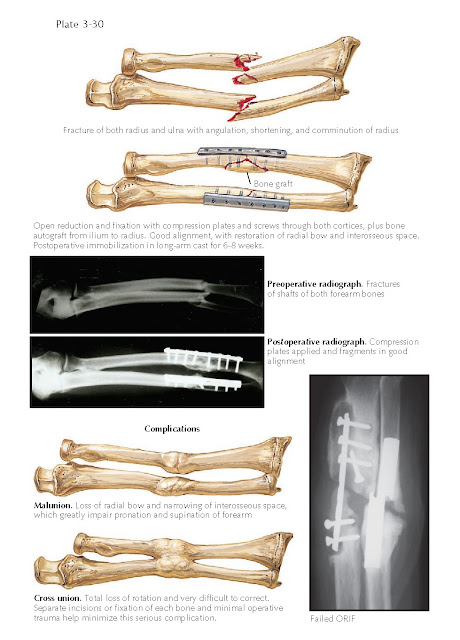FRACTURE OF BOTH FOREARM BONES
Fractures of the shafts of the radius and ulna are usually significantly
displaced and are often comminuted because of the great force needed to break
these strong bones. Anatomic reduction of the fractures, with full restoration
of both the length and the bow of the radius, is essential to maintain maximal
function of the forearm. Even when anatomic reduction is achieved, some
long-term loss of supination and pronation may occur.
ORIF of fractures of both forearm
bones is performed through separate incisions, maximizing the skin bridge left
between the two. Both fractures must be reduced and held with clamps before
either is permanently fixed; this ensures that both fractures are reduced
anatomically and that the reductions are maintained. After the temporary
reductions are secured, the less comminuted fracture (usually the ulna) is
fixed with a compression plate and screws; the more comminuted fracture is
fixed subsequently using the same technique.
A number of difficulties may be
encountered during the surgical procedure. Extensive comminution may make it
difficult to restore the bones to their proper length. In this situation, the
interosseous membrane is identified, proximally and distally, and used as a
guide in restoring the bones to an adequate length. Recreation of the
anatomic bow of the radius is critical, and loss of the normal geometry will
lead to permanent loss of forearm rotation. In wound closure, the fascia is
left open and only the skin is closed, because tight fascial closure combined
with postoperative swelling may produce a compartment syndrome.
Long-term problems associated with
fractures of both forearm bones include nonunion, infection, limited motion,
and synostosis between the radius and the ulna. Synostosis is rare and is
usually associated with comminuted fractures at the same level in the forearm
that result from crushing forces. Operative fixation through one exposure is
another well-documented cause of synostosis. Nonunion can occur from inadequate
fixation (e.g., using plates of insufficient strength or
of improper length). One must ensure that six cortices of fixation on each side
of the fracture are achieved, and 1/3 tubular plates (although
easy to contour) are never appropriate for operative fixation of forearm
fractures. Nonunion also occurs with closed reduction and plaster cast
immobilization, and in the adult population fractures of both forearm bones are
an absolute indication for ORIF.





